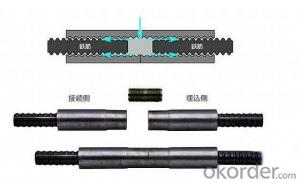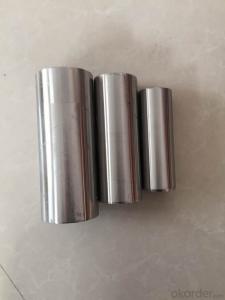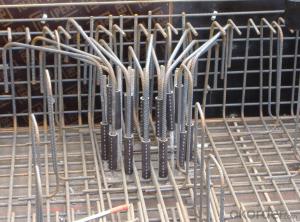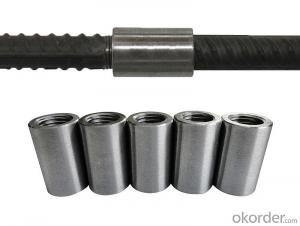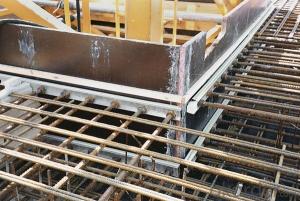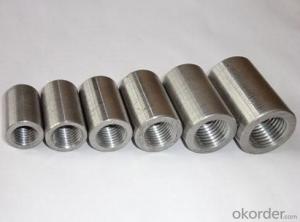Steel Coupler Rebar Scaffolding In Dubai Wedge Lock Scaffolding
- Loading Port:
- Shanghai
- Payment Terms:
- TT OR LC
- Min Order Qty:
- 1000 pc
- Supply Capability:
- 10000000 pc/month
OKorder Service Pledge
OKorder Financial Service
You Might Also Like
Steel Coupler Rebar Scaffolding In Dubai Wedge Lock Scaffolding
1.Description:
Lapped joints are not always an appropriate means of connecting rebar. The use of Steel Rebar Couplers can simplify the design and construction of reinforced concrete and reduce the amount of reinforcement required.
The threaded steel coupler system is designed as a threaded reinforcement connection with 100% load transmission. The steel coupler rebar connection system is suitable for both static and dynamic load transmission in construction joints.
The coupler is designed as a threaded reinforcement connection for formed construction joints. Reinforcement work is normally carried out on both sides of the construction joint using lap joints or one side is anchored. The bar lengths are based on the structural analysis requirements of the building component and are calculated from anchorage and lap lengths.
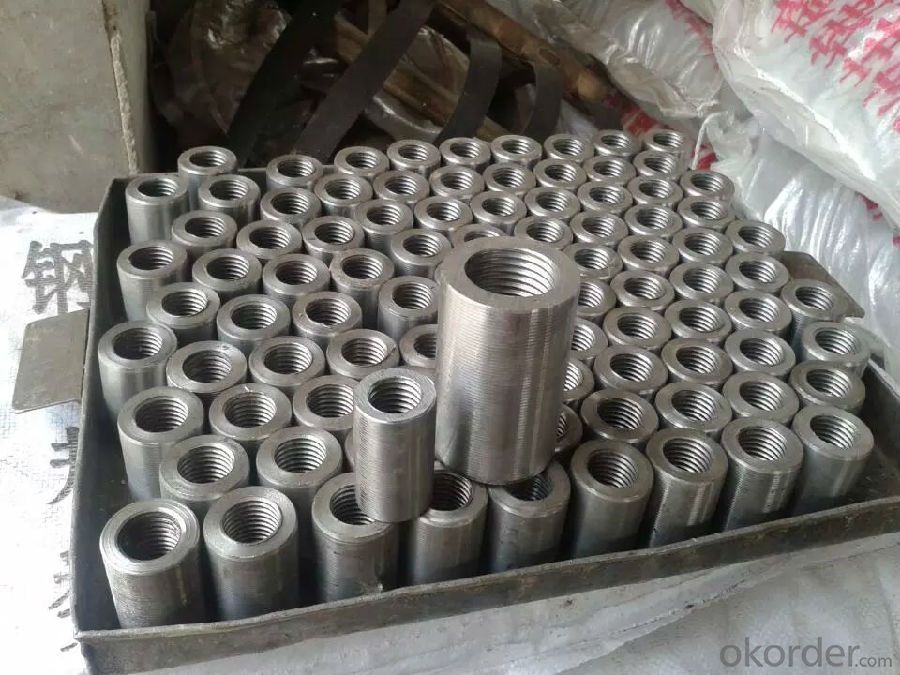

2.Advantages of Steel Coupler Rebar Lift Scaffolding Galvanized Scaffolding Tube with Low Price:
The coupler system provides the opportunity to connect rebars quickly, easily and cost effectively, even when large rebar diameters are used. This makes the steel coupler rebar range a logical extension to our rebendable CNBM reinforcement continuity system for rebars over 12 mm.
3.Available sizes of Steel Coupler Rebar Lift Scaffolding Galvanized Scaffolding Tube with Low Price:
14mm,16mm,18mm,20mm,22mmm,25mm,28mm,32mm,36mm,40mm
4.Delivery:
Delivery Term: FOB / CFR / CIF available.
Delivery Time: 15 days or less after order confirmed.
5.Why choose us?
Technical Expertise
Experienced Management
Stringent Quality Control
Exemplary Service
On-Time Delivery
Wide Product Range
Competitive Pricing
Huge branch network capable of catering worldwide
- Q: What are the considerations when designing steel formwork for swimming pools?
- When designing steel formwork for swimming pools, there are several key considerations that need to be taken into account. Firstly, the structural strength of the formwork is crucial as it needs to withstand the weight of the concrete and the water pressure once the pool is filled. The formwork should be made of high-quality steel that is able to support these loads without any deformation or failure. Additionally, the design should ensure proper alignment and support to achieve the desired shape and dimensions of the swimming pool. Attention should be given to the corners, curves, and transitions to ensure smooth and even concrete placement. The formwork should also allow for easy and efficient installation and removal. Considering the time and labor involved in constructing a swimming pool, a well-designed formwork system can greatly streamline the process and save on costs. Modular or adjustable formwork systems can be beneficial in this regard. Furthermore, the formwork should be able to withstand the chemical exposure from the pool water and any necessary maintenance or repairs. It should be resistant to corrosion and have a long lifespan to avoid frequent replacements. Lastly, safety measures should be incorporated into the design to protect workers during the construction phase. This can include features like sturdy handrails, non-slip surfaces, and proper access points. Overall, designing steel formwork for swimming pools requires careful consideration of structural integrity, ease of installation, durability, and safety to ensure a successful and long-lasting construction project.
- Q: Can steel formwork be used in areas with extreme temperature variations?
- Yes, steel formwork can be used in areas with extreme temperature variations. Steel has a high strength-to-weight ratio and is resistant to temperature changes, making it suitable for use in various conditions. It can withstand both high and low temperatures without structural deformation or deterioration. Additionally, steel formwork provides excellent stability and durability, ensuring that it can withstand the stress caused by extreme temperature fluctuations. However, it is important to consider thermal expansion and contraction effects when using steel formwork in areas with extreme temperature variations, as this may impact the accuracy of the formwork and the final concrete structure. Proper design considerations and installation techniques can help mitigate any potential issues related to temperature variations.
- Q: How does steel formwork contribute to the overall cost of concrete construction?
- Steel formwork can significantly contribute to the overall cost of concrete construction due to its initial higher cost compared to other formwork materials such as wood or plastic. However, it offers various advantages such as durability, reusability, and the ability to withstand higher loads, resulting in reduced labor and material costs in the long run. Moreover, steel formwork provides better quality finishes, faster construction time, and improved safety on-site, which can lead to overall cost savings and enhanced project efficiency.
- Q: How does steel formwork handle different concrete strength requirements?
- Steel formwork proves to be a highly versatile and durable solution, capable of effectively managing a wide range of concrete strength demands. Concrete strength is influenced by its mixture proportions, curing conditions, and the quality of materials employed. By providing a reliable and secure framework for pouring concrete, steel formwork plays a pivotal role in fulfilling these requirements. One notable advantage of steel formwork lies in its ability to withstand the immense pressures and strong vibrations encountered during concrete pouring and compaction. This becomes particularly crucial when dealing with high-strength concrete, as it necessitates greater force application to attain the desired density and durability. Thanks to its structural integrity and rigidity, steel formwork can bear these forces without deformations or failures, consequently ensuring a consistent and uniform distribution of the concrete. Another key benefit of steel formwork is its flexibility in terms of shape and size, allowing for customization to accommodate diverse concrete strength specifications. This versatility facilitates the construction of various structural elements, including columns, beams, walls, and slabs, each with unique strength requirements. Additionally, steel formwork can be effortlessly assembled and disassembled, making it adaptable to different projects and enabling the reuse of formwork components. Moreover, steel formwork imparts a smooth and precise finish to the concrete surface, a crucial factor in achieving desired aesthetics and functionality. This is particularly important for architectural or decorative concrete, where a high-quality finish is imperative. The smooth and flat surface provided by steel formwork ensures even curing of the concrete and minimizes the risk of surface defects. To summarize, steel formwork is well-suited to handle diverse concrete strength requirements due to its robustness, durability, adaptability, and ability to deliver a smooth finish. Its strength and flexibility make it an ideal choice for construction projects demanding varying concrete strengths, guaranteeing the successful execution of diverse structural designs and meeting performance expectations.
- Q: How is steel formwork used in construction projects?
- Steel formwork is commonly used in construction projects as a temporary mold or framework to hold wet concrete in place until it sets and hardens. It provides the necessary support and shape for the concrete, allowing it to be poured and molded into desired structures such as walls, columns, beams, and slabs. Steel formwork offers durability, strength, and reusability, making it a preferred choice for large-scale projects that require high-quality finishes and precise dimensions.
- Q: How does steel formwork affect the overall project budget and cost control?
- Steel formwork has the potential to significantly impact the overall project budget and cost control. To start with, steel formwork offers a durable and reusable alternative to traditional timber formwork. Although the initial investment in steel formwork may be higher, it can be utilized for multiple projects, resulting in long-term cost savings. Moreover, steel formwork provides greater accuracy and precision, leading to reduced material wastage and labor costs. The precise dimensions and alignment offered by steel formwork contribute to improved quality and faster construction, thereby reducing the overall project duration and associated expenses. Additionally, steel formwork is renowned for its strength and stability, enabling higher concrete pouring rates and larger pour sizes. This enhances productivity and reduces the necessary labor, positively impacting the project budget. Furthermore, steel formwork necessitates less maintenance and repairs, thus decreasing ongoing expenses. Unlike timber formwork, steel formwork is not susceptible to rot, warping, or damage caused by insects, weather, or repetitive use. The longevity and durability of steel formwork help minimize replacement and repair costs. However, it is crucial to consider that the installation and removal of steel formwork may require specialized skills and equipment. This can affect labor costs and may necessitate additional training or the hiring of experienced workers, which should be taken into account when planning the project budget. In conclusion, the utilization of steel formwork can have a positive impact on the overall project budget and cost control due to its durability, reusability, accuracy, efficiency, and reduced maintenance requirements. Although the initial investment may be higher, the long-term benefits, such as reduced material wastage, improved quality, increased productivity, and decreased repair costs, make steel formwork a cost-effective choice for construction projects.
- Q: Can steel formwork be used for complex geometric shapes?
- Complex geometric shapes can indeed be created using steel formwork. Steel, being an incredibly versatile and malleable material, can easily be molded and shaped to fulfill the demands of various intricate designs. Its outstanding strength and durability make it ideal for constructing formwork for elaborate architectural and structural shapes. With steel formwork, it is possible to fabricate and tailor the angles, curves, and dimensions precisely, enabling the realization of intricate and distinctive shapes in construction projects. Moreover, steel formwork can be reused numerous times, making it a cost-effective choice for projects that necessitate complex geometric shapes. All in all, steel formwork offers the essential flexibility, strength, and durability needed to effectively accommodate complex architectural and structural designs.
- Q: Can steel formwork be used for architectural concrete walls?
- Indeed, architectural concrete walls can utilize steel formwork. Its high strength and durability render it appropriate for fashioning intricate shapes and designs in such walls. Moreover, it imparts a sleek and uniform finish to the concrete surface, guaranteeing a visually pleasing appearance of superior quality. What's more, steel formwork can be reused, thereby proving to be economical for expansive ventures. Besides, it can be effortlessly assembled and disassembled, facilitating efficient construction procedures. All in all, thanks to its versatility, strength, durability, and cost-effectiveness, steel formwork remains a widely favored option for architectural concrete walls.
- Q: How does steel formwork handle formwork alignment and leveling?
- Steel formwork is known for its excellent alignment and leveling capabilities. It is constructed using rigid steel panels, which are precisely manufactured to meet specific dimensions and tolerances. These panels are designed to interlock seamlessly, ensuring a tight fit and accurate alignment. Additionally, steel formwork is equipped with adjustable mechanisms such as screws and wedges, allowing users to fine-tune the alignment and levelness according to their requirements. This flexibility and precision make steel formwork highly effective in achieving consistent and precise formwork alignment and leveling.
- Q: How does steel formwork handle different concrete workability levels?
- Steel formwork is a flexible and long-lasting material that effectively handles various levels of concrete workability. Workability refers to how easily concrete can be mixed, placed, compacted, and finished. When dealing with different workability levels in concrete, steel formwork offers several advantages. Firstly, its sturdy and rigid structure can withstand the pressure exerted by concrete during pouring and compaction. This ensures that the formwork remains stable and does not deform or collapse under the weight of the concrete. Furthermore, steel formwork provides a smooth and uniform surface for the concrete, regardless of its workability. This is crucial for achieving a high-quality finish and minimizing defects like honeycombing or uneven surfaces. The smoothness of steel formwork allows for easy and efficient removal, ensuring that the concrete retains its shape and integrity. Moreover, steel formwork can be easily customized and adjusted to accommodate different workability levels. Its modular nature allows for easy assembly and disassembly, making it suitable for various construction projects and types of concrete. Steel formwork can be adjusted to fit changes in concrete consistency, ensuring that the formwork remains tight and secure. This adaptability is particularly beneficial when working with concrete mixes that have different slump values or consistencies. Another advantage of steel formwork is its reusability. Unlike other forms of formwork, such as wood or plastic, steel formwork can be used multiple times without compromising its structural integrity. This not only reduces construction costs but also allows for efficient handling of concrete with different workability levels. Steel formwork can be easily cleaned, repaired, and reused, making it a cost-effective and sustainable choice for handling various levels of concrete workability. In conclusion, steel formwork provides a dependable and flexible solution for handling different levels of concrete workability. Its strength, smoothness, adjustability, and reusability make it an ideal choice for ensuring the stability, quality, and efficiency of concrete construction projects.
Send your message to us
Steel Coupler Rebar Scaffolding In Dubai Wedge Lock Scaffolding
- Loading Port:
- Shanghai
- Payment Terms:
- TT OR LC
- Min Order Qty:
- 1000 pc
- Supply Capability:
- 10000000 pc/month
OKorder Service Pledge
OKorder Financial Service
Similar products
Hot products
Hot Searches
Related keywords
